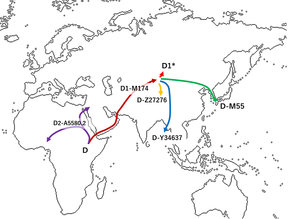Haplogroup D-M55 (M64.1/Page44.1) also known as Haplogroup D1a2a is a Y-chromosome haplogroup. It is one of two branches of Haplogroup D1a. The other is D1a1, which is found with high frequency in Tibetans and other Tibeto-Burmese populations and geographical close groups. D is also distributed with low to medium frequency in Central Asia, East Asia, and Mainland Southeast Asia.
| Haplogroup D-M55 | |
|---|---|
| Possible time of origin | 45,357 (95% CI 52,258 - 39,364) ybp[1] 45,200 (95% CI 48,500 <-> 42,000) ybp[2] |
| Coalescence age | 21,434 (95% CI 24,812 - 18,513) ybp[3] 21,000 (95% CI 22,800 <-> 19,300) ybp[2] |
| Possible place of origin | possibly Japanese archipelago |
| Ancestor | D-M174 |
| Defining mutations | M55, M57, M64.1, M179, P37.1, P41.1, P190, 12f2b |
| Highest frequencies | Japanese people, Jōmon people, Ainu people、 Ryukyuan people |
Haplogroup D-M55 is found in about 33%[4][5][6][7][8] of present-day Japanese males. It has been found in fourteen of a sample of sixteen or 87.5% of a sample of Ainu males in one study published in 2004[9] and in three of a sample of four or 75% of a sample of Ainu males in another study published in 2005 in which some individuals from the 2004 study may have been retested.[5] It is currently the most common Y-DNA haplogroup in Japan if O1-F265 and O2-M122 (TMRCA approx. 30,000 ~ 35,000 ybp) are considered as separate haplogroups. Haplogroup D-M55 may have been born in Japan at any time between its MRCA with D-Y34637 (found in present-day Onge and Jarawas) about 45,000 years ago and the MRCA of all extant branches of D-M55 about 21,000 years ago.
In 2017 it was confirmed that the Japanese branch of haplogroup D-M55 is distinct and isolated from other branches of haplogroup D since about 50,000 years ago. The split in D1a may have occurred near the Tibetan Plateau.[10]
History


Among the subgroups of Haplogroup D, the ancestor of D-M55 went eastward to reach the Japanese archipelago.[11] According to Michael F. Hammer of the University of Arizona, haplogroup D originated near the Tibetan Plateau and migrated into Japan were it eventually became D-M55.[12] Mitsuru Sakitani said that Haplogroup D1 came from Tibet to northern Kyushu via the Altai Mountains and the Korean Peninsula more than, and Haplogroup D-M55 (D1a2a) was born in the Japanese archipelago.[11]
Recent studies suggest that D-M55 became dominant during the late Jōmon period, shortly before the arrival of the Yayoi, suggesting a population boom and bust.[13]
Frequency
The average frequency in Japanese is about 33%.[4][5][7][8] High frequencies are found in various places in Japan, especially in Hokkaidō, eastern Honshū, southern Kyūshū, and Okinawa.
- Ainu people: 87.5%(Tajima et al. 2004[9])
- Asahikawa (Hokkaido): 63.7% (estimated from Y-STR haplotypes)[7]
- Chiba: 45.5%[14]
- Tokyo: 40.4% (21/57 = 36.8% JPT, 23/52 = 44.2%[14])
- Okinawa: 37.6% (0/7 Hateruma,[15] 1/20 = 5.0% Iriomote,[15] 8/29 = 27.6% Katsuren,[15] 10/32 = 31.3% Yomitan,[15] 16/49 = 32.7% Ishigaki,[16] 13/38 = 34.2% Miyako,[16] 13/36 = 36.1% Haebaru,[16] 7/19 = 36.8% Gushikami,[15] 35/87 = 40.2% Okinawa estimated from Y-STR haplotypes,[7] 38/80 = 47.5% Itoman,[15] 25/45 = 55.6% Okinawa[5])
- Kanto region: 37.6%[4]
- Kyushu: 35.0% (8/31 = 25.8% Fukuoka Prefecture,[17] 29/104 = 27.9% Kyushu,[9] 90/300 = 30.0% Nagasaki college students,[8] 39/129 = 30.2% Saga Prefectural Chienkan Senior High School students,[16] 34/102 = 33.3% Fukuoka adult men,[8] 7/21 = 33.3% Nagasaki Prefecture,[17] 13/37 = 35.1% Ōita Prefecture,[17] 95/270 = 35.2% Miyazaki Prefecture,[18] 470/1285 = 36.6% Miyazaki Prefecture,[17] 58/151 = 38.4% Kagoshima Prefecture,[17] 5/11 = 45.5% Saga Prefecture,[17] 22/47 = 46.8% Kumamoto Prefecture[17])
- Nagoya: 34.3% (estimated from Y-STR haplotypes)[7]
- Sapporo: 33.9% (100/302 = 33.1% Sapporo college students,[8] 72/206 = 35.0% Sapporo adult men[8])
- Kawasaki: 33.0%[8]
- Shizuoka: 32.8%[5]
- Kanazawa: 32.6% (97/298 = 32.6%,[8] 76/232 = 32.8%[8])
- Aomori: 31.1% (22/79 = 27.8%,[16] 11/27 = 40.7%[5])
- Shikoku: 30% (18/70 = 25.7% Tokushima,[5] 9/31 = 29.0% Shikoku,[17] 119/388 = 30.7% Tokushima college students[8])
- Micronesia: 1/17 = 5.9%(Hammer et al. 2006[5])
- South Korea: 3/75 = 4.0% (Hammer et al. 2006[5]), 12/317 = 3.8% (estimated from Y-STR haplotypes),[7] 8/506 = 1.6% (Kim et al. 2011[19])
- West Timor: 1/497 = 0.2%(Tumonggor et al. 2014[20])
Ancient DNA
A Jōmon period man excavated from Funadomari remains (about 3,800 - 3,500 YBP) in Rebun Island in Hokkaido belongs to Haplogroup D1a2a2a(D-CTS220).[21]
The analysis of an Jōmon sample (Ikawazu) and an ancient sample from the Tibetan Plateau (Chokhopani, Ch) found only partially shared ancestry, suggesting a positive genetic bottleneck regarding the spread of haplogroup D from an ancient population related to the Tibetan Chokhopani sample (and modern Tibeto-Burmese groups).[22]
Phylogenetic tree
By ISOGG tree(Version: 14.151).[23]
- DE (YAP)
- D (CTS3946)
- D1 (M174/Page30, IMS-JST021355, Haplogroup D-M174)
- D1a (CTS11577)
- D1a1 (F6251/Z27276)
- D1a1a (M15) Tibet
- D1a1b (P99) Tibet, Mongol, Central Asia
- D1a2(Z3660)
- D1a2a (M64.1/Page44.1, M55) Japan(Yamato people、Ryukyuan people、Ainu people)
- D1a2b (Y34637) Andaman Islands(Onge people, Jarawa people)[24][25]
- D1a1 (F6251/Z27276)
- D1b (L1378) Philippines[26]
- D1a (CTS11577)
- D2 (A5580.2) Nigeria, African American, Saudi Arabia, Syria[27][28]
- D1 (M174/Page30, IMS-JST021355, Haplogroup D-M174)
- D (CTS3946)